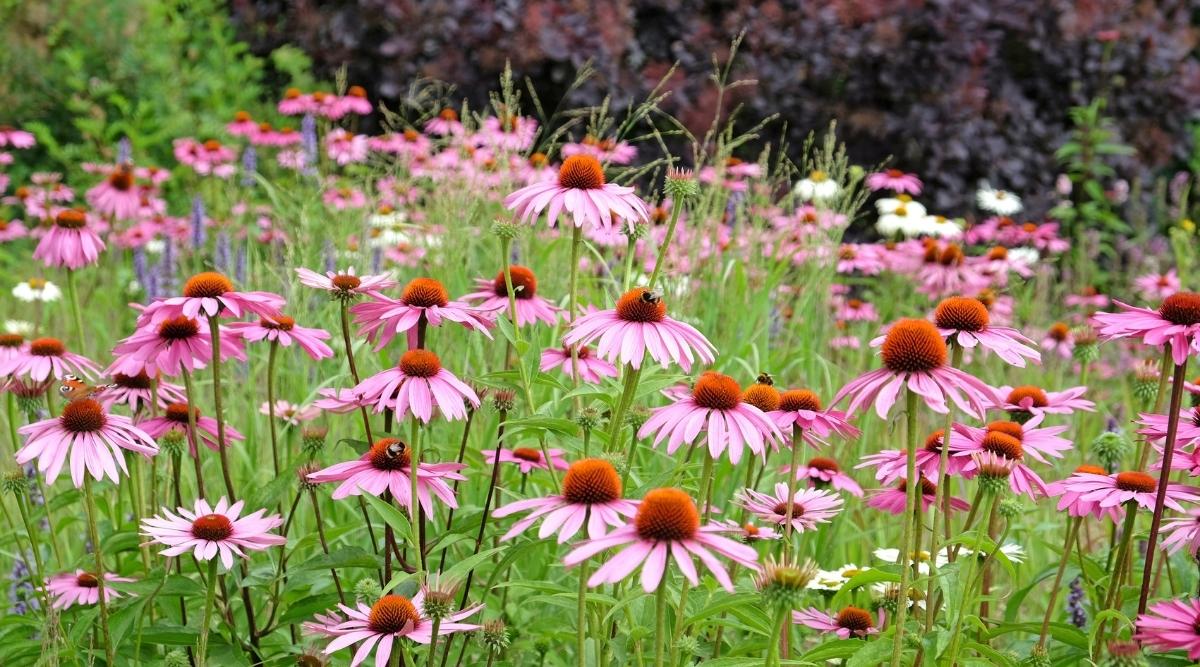shadetreeinc.com – Coneflower (Echinacea) is a popular and stunning wildflower that has won the hearts of gardeners and plant enthusiasts worldwide. Known for its vibrant, daisy-like flowers and medicinal properties, the coneflower is a versatile plant that thrives in various landscapes. Whether for its beauty, ecological benefits, or healing qualities, the coneflower continues to be a beloved addition to gardens and natural areas alike.
Description and Features
Coneflowers are characterized by their large, prominent blooms, which feature a central, cone-shaped disc surrounded by slender, drooping petals. The most common flower color is purple, but coneflowers also come in shades of white, pink, red, orange, and yellow. The striking central cone, which is made up of tightly packed disc florets, is often a dark brown or green color, adding an intriguing contrast to the surrounding petals.
These plants typically grow between 2 to 5 feet tall, with long, lance-shaped leaves that add texture to the plant’s overall appearance. Coneflowers are known for their hardiness and resilience, able to withstand a range of growing conditions, making them an excellent choice for various garden designs.
Habitat and Distribution
Native to North America, coneflowers are primarily found in prairies, meadows, and open woodlands. They are well-suited to dry, well-drained soil and full sun, although they can tolerate some partial shade. The plant thrives in temperate climates and is commonly found in regions with moderate rainfall and seasonal changes.
Coneflowers are commonly seen in wildflower meadows, prairie restoration projects, and natural gardens, where they contribute both beauty and biodiversity. Over the years, the coneflower has been cultivated in gardens around the world, becoming a favorite among gardeners for its ease of care and vibrant appearance.
Ecological Importance
One of the primary reasons coneflowers are valued in gardens and natural areas is their role in supporting pollinators. The large, colorful blooms attract a variety of pollinating insects, including bees, butterflies, and even hummingbirds. The central cone of the flower provides a rich source of nectar, making it a popular stop for these beneficial creatures.
Additionally, coneflowers are known to attract a variety of birds, particularly goldfinches, which feed on the seeds once the flowers have gone to seed. As a result, coneflowers contribute to local biodiversity, supporting a variety of wildlife while adding visual interest to landscapes.
Medicinal and Therapeutic Uses
Coneflower, specifically Echinacea purpurea, is perhaps best known for its medicinal properties. For centuries, coneflowers have been used in traditional medicine, particularly by Native American cultures, to treat a wide range of ailments. The plant’s roots, flowers, and leaves contain compounds believed to have immune-boosting and anti-inflammatory properties.
Echinacea is commonly used in herbal supplements, teas, and tinctures to support the immune system and help prevent or treat colds, respiratory infections, and other illnesses. While scientific research is still ongoing to fully understand its benefits, many people continue to use coneflower as a natural remedy for its purported healing properties.
Cultivation and Care
Coneflowers are relatively easy to grow, making them an excellent choice for both beginner and experienced gardeners. These plants thrive in well-drained soil with full sunlight but can tolerate a variety of soil types, from sandy to clay-rich. Once established, coneflowers are drought-tolerant and can survive on minimal water, making them ideal for xeriscaping and low-maintenance gardens.
To encourage healthy growth and extended blooming, it is advisable to deadhead spent flowers regularly. This promotes new flower production and prevents the plant from going to seed too early. Coneflowers can be propagated from seed, division, or cuttings, and they typically bloom from late spring to early fall.
Symbolism and Cultural Significance
In addition to its beauty and medicinal uses, the coneflower holds symbolic meaning in various cultures. It is often associated with strength, healing, and resilience due to its long history of medicinal use and ability to thrive in diverse conditions. In the language of flowers, the coneflower symbolizes endurance and protection, qualities that have made it a popular choice for gardens that aim to inspire well-being and positivity.
Conclusion
The coneflower is a versatile and enduring plant that offers much more than just aesthetic appeal. With its striking blooms, ecological benefits, and long history of medicinal use, it is no wonder that the coneflower continues to be a beloved addition to gardens, meadows, and natural landscapes. Whether appreciated for its vibrant colors, its support of local wildlife, or its potential health benefits, the coneflower remains a flower that stands the test of time.
